In this week's NewsFlash we find out why the Amazon rainforest could become a carbon criminal, a new way to predict avalanches, and we celebrate the passing of DD45 - a Near Earth Object so close it was inside the orbit of the Moon. Plus, Sarah Castor-Perry explains how this week in 1876 saw the very first telephone conversation...
In this episode
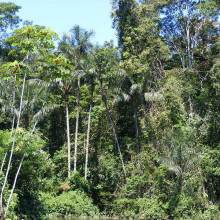
Rock the Amazon at your peril
In a massive study scientists have shown that climate change could turn the Amazon rainforest from a carbon ally into a carbon criminal.
Writing in this week's Science Leeds University ecologist Professor Oliver Phillips, together with an international team of more than 60 collaborators, describes how he and his colleagues have studied 136 "plots" of rainforest to understand the impact of future climate change on the ability of the Amazon to soak up CO2. Specifically the team compared how the plots performed historically with the effect of a prolonged drought in 2005.
 "We measured trees and wood density to calculate how much biomass was present," says Phillips. The team found that in years leading up to 2005 the Amazon was a powerful carbon "sink", locking away more than a tonne of carbon per hectare per year.
"We measured trees and wood density to calculate how much biomass was present," says Phillips. The team found that in years leading up to 2005 the Amazon was a powerful carbon "sink", locking away more than a tonne of carbon per hectare per year.
But the drought led to the death of trees and growth arrest, turning what was a carbon sink into a carbon source with areas losing up to 2 tonnes of carbon (as carbon dioxide due to breakdown of the wood and foliage) per hectare per year.
The significance of this result is that the 2005 drought was provoked by warmer-than-normal north Atlantic water, which also triggered Hurricane Katrina and led to the flooding parts of New Orleans. But it had the reverse effect over the Amazon, and if global warming continues we might therefore see a drier Amazon more often. This would mean that the billions of tonnes of carbon locked away by the rainforest every year would cease to be removed from the atmosphere and at the same time the Amazon would become a net producer of carbon. The affect would be a dramatic acceleration of the greenhouse effect, with predictable global consequences.
"This should provoke a re-think of the political agenda," says Phillips.

Cig addiction could be in your genes
Tobacco causes around a quarter of all cancer deaths in the UK, as well as heart disease, lung disease and other heart problems. And it's a fiercely addictive drug, meaning that people find it hard to give up. But some people do manage to quit the cigs relatively easily, while other fight a life-long battle. And what makes some people become addicted after just a few puffs, while others can smoke a few cigarettes then just stop.
 Now researchers from across the US have used the latest DNA analysis techniques to hunt for genes linked to smoking behaviour, with the hope of shedding light on this conundrum.
Now researchers from across the US have used the latest DNA analysis techniques to hunt for genes linked to smoking behaviour, with the hope of shedding light on this conundrum.
The team looked at DNA from over 2,300 men and more than 2,200 women - a mixture of smokers and non-smokers - and looked at their smoking behaviour. This included the number of cigarettes smoked per day, age they started smoking, how long they had smoked for, and pack years (for example, one pack year is the equivalent of smoking one pack day for a year, or half a pack a day for two year). The scientists also looked at whether the people had ever smoked, or if they had managed to give up.
The researchers used so-called SNP ("snip") analysis to track down potential genes linked to specific smoking behaviours. In total, around 2,600 of the people in the study had ever smoked. Although they didn't find any new genes linked to smoking, the results provided more evidence to support the existence of an important gene on chromosome 15 linked to the number of cigarettes smoked per day.
The team also found evidence for variations in genes encoding nicotine receptors being involved in some smoking behaviours, as might be expected, including the number of cigs smoked per day, the number of pack years, and the age they started smoking. And they also found a link between variations in a gene region called MAOA on the X chromosome and whether people smoked more or less than 10 cigarettes per day.
This is an intriguing gene, as some studies have shown possible links with alcoholism and Parkinson's disease, so it needs more investigation. And another interesting result was a link between variations at alcohol dehydrogenase genes and whether a person had ever smoked, or never smoked. So perhaps these genes are linked to whether a person actually ever starts smoking.
But the main thing the team took from their study was that the links between any of these genes and specific smoking behaviours, although it has thrown up some interesting candidates that merit further research. But the true picture is likely to be very complex, involving social as well as genetic factors.
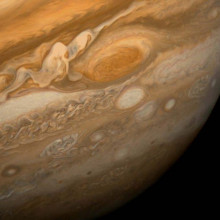
Hungry Jupiter
Scientists have spent a lot of time trying to simulate the birth of the solar system, partly to try and understand our solar system and partly to try and estimate how many other similar solar systems there are out there. But one thing that has confused them is Jupiter's moons - there aren't enough of them. According to all the simulations the moons of Jupiter should have made up about 10% of the total mass of Jupiter but they seem to only make up about 2%.
Robin Canup of the Southwest Research Institute, Colorado may have worked out where all those moons have gone. They have been eaten by Jupiter itself. Jupiter and its moons were formed out of a disk of gas and lumps of rock and ice orbiting itself. This then slowly collapsed under gravity as it lost energy to friction between the lumps of material. Moons which formed very early on in this process would have been surrounded by this disc which would have slowed them down causing them to fall lower and lower until they were swallowed up by Jupiter itself.
Jupiter could have swallowed up to 5 generations of moons, with those visible today being the last ones to form as the disk finally dissipated leaving them to continue orbiting for the intervening billions of years.
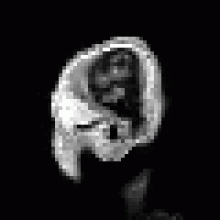
Spying on the sense of self
One of the most intriguing areas of neuroscience at the moment is the issue of the "sense of self" - basically, how we are aware of our own thoughts and personality. Previous research has shown that a few areas of the brain - the prefrontal cortex, the posterior cingulated cortex, and the parietal regions - are involved in self-reflection, and processing our sense of self.
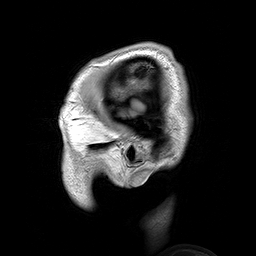 But can we draw a distinction between regions of the brain that are specifically involved in processing thoughts about our "self" from those that are involved in processing thoughts about people in general? New results from researchers in the Netherlands using functional MRI scanning have provided a clue - our sense of self may reside (at least partly) in a region called the anterior insula, deep in the forebrain, which is part of the brain linked to feelings and emotions.
But can we draw a distinction between regions of the brain that are specifically involved in processing thoughts about our "self" from those that are involved in processing thoughts about people in general? New results from researchers in the Netherlands using functional MRI scanning have provided a clue - our sense of self may reside (at least partly) in a region called the anterior insula, deep in the forebrain, which is part of the brain linked to feelings and emotions.
The researchers used sixteen young male volunteers an put them in a functional MRI scanner, which looks at the activity levels of different regions of the brain. They were shown three different types of statements, and were asked to say whether they were true about them, like "I am a good friend", about someone they knew like a team-mate or classmate, like "So-and-so talks too much", or just a general knowledge fact like "a vertebra is a bone".
While asking the volunteers to carry out the task, the researchers monitored their brain activity. They found that when the volunteers were considering the statements about themselves, there was activity in the anterior insula, but this wasn't seen so much when they were thinking about the general knowledge statements. And, crucially, activity in the anterior insula wasn't seen when they were thinking about other people.
The team found activity in regions such as the medial prefrontal cortex and the posterior insula when the volunteers were thinking either about themselves or about another person. But the scientists only saw extra activity in the anterior insula when the volunteers thought about statements related to themselves.
These kind of studies are important, not only for scientific interest, but for psychiatrists. There are several illnesses in which a person's sense of self is disturbed, including schizophrenia. Understanding more about the parts of the brain that are involved could shed light on the roots of these complex diseases, if neuroscientists focus more on them.
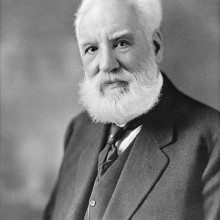
12:27 - The Amazon, Avalanches and Near Earth Objects
The Amazon, Avalanches and Near Earth Objects
In this week's NewsFlash we find out why the Amazon rainforest could become a carbon criminal, a new way to predict avalanches, and we celebrate the passing of DD45 - a Near Earth Object so close it was inside the orbit of the Moon. Plus, Sarah Castor-Perry explains how this week in 1876 saw the very first telephone conversation...
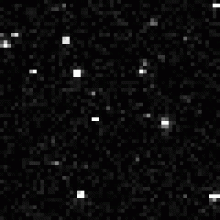
14:39 - Near Earth Objects - DD45's Near Miss
Near Earth Objects - DD45's Near Miss
Professor Alan Fitzsimmons, Queens University Belfast
Chris - If you have been watching the news this week then you might have noticed that the Earth had a brush with a near-Earth object. You might have been forgiven for letting it pass you by which is luckily what happened to the Earth this week. But we did have a close encounter with DD45. To tell us what DD45 was here's Professor Alan Fitzsimmons from Queens University in Belfast. Hello, Alan.
Alan - Hello there.
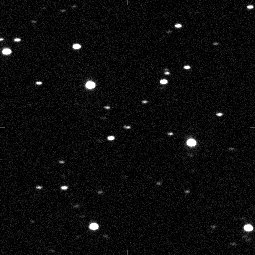
2004 FH is the centre dot being followed by the sequence; the object that flashes by near the end is an artificial satellite.
Images obtained by Stefano Sposetti, Switzerland on March 18, 2004. Animation made Raoul Behrend, Geneva Observatory, Switzerland. (c) NASA' alt='Timelapse of Asteroid 2004 FH's flyby (NASA/JPL Public Domain)' >Chris - Tell us about this object, what is it?
Alan - It's a small asteroid. It's about between 20-40m across. It was discovered only just over a week ago, on Friday 27th February. It passed our planet by at a distance of only 72,000km on Tuesday.
Chris - That's extremely close. That's, let's put that in perspective. Satellites orbit the Earth about 25,000 miles out. That's only twice as far away as a geostationary satellite.
Alan - That's right. Occasionally we do spot these small asteroids coming past us. Objects of that size hit the earth probably about once every 2-300 years. We're not quite sure how often they hit us at the moment but they hit us on time scales of centuries.
Chris - Had this thing not been seventy thousand kilometres away and it had actually landed on the Earth what sort of damage would it have done? How would it compare with, say, the object that wiped out the dinosaurs?
Alan - Well, it's much smaller than that. The object that wiped out the dinosaurs was about ten kilometres across and had global consequences. Those objects only hit us about once ever hundred million years. An object that can cause climate change can be as small as one kilometre across, however. Even they only hit us once every million years or so. Something this size may have been similar to the object that entered our atmosphere over Tunguska in Siberia in 1908. It may have exploded low down in the atmosphere if it had entered our atmosphere and perhaps about a few kilometres up. It would have wiped out several square thousand kilometres of ground.
Chris - That's city devastating sort of level. How did we miss this kind of object? I thought we had, I was reassured to learn we had systems in place to spot these things so we could take action.
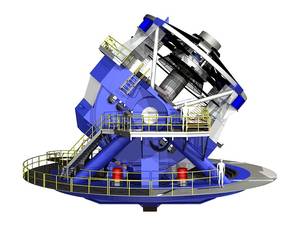 Alan - Well, it's because the systems we have in place are designed to spot the larger asteroids, the one kilometre guys and larger - the ones that would affect the entire planet. They're too small to effectively catalogue all the much smaller objects. At the moment the next generation of survey telescopes is in construction. There's something call Pan-STARRS which starts operating this year in Hawaii. Then sometime in the next decade, towards the end of the next decade something called the large synoptic survey telescope will get going in Chile. Even those telescopes won't be able to catalogue all the objects about the same size as DD45. We're just going to have to keep watching and surveying the sky.
Alan - Well, it's because the systems we have in place are designed to spot the larger asteroids, the one kilometre guys and larger - the ones that would affect the entire planet. They're too small to effectively catalogue all the much smaller objects. At the moment the next generation of survey telescopes is in construction. There's something call Pan-STARRS which starts operating this year in Hawaii. Then sometime in the next decade, towards the end of the next decade something called the large synoptic survey telescope will get going in Chile. Even those telescopes won't be able to catalogue all the objects about the same size as DD45. We're just going to have to keep watching and surveying the sky.
Chris - Where did DD45 come from and given that it was so close this time round is it or is there any chance it might go round again and have another go?
Alan - The asteroid's in orbit around the sun just as everything else is in our solar system. It has an orbital period of just over 1.5 years. It's orbit just happens to have a point in it where it's very close to the Earth's orbit. Roughly once every March if the asteroid's there and the Earth is there it can come close to us. At the moment it can't hit us. The next time it will come close to us will actually be on the third of March in the year 2067 when even then it will pass by twice as far as it did this week. Over the coming centuries and thousands of years it's orbit will change slightly due to the gravitational tugs of the Earth and the other planets. It may well end up hitting us in a few thousand years' time. We don't know at the moment we haven't got enough data on it at the moment.
Chris - So unless you're Bruce Forsyth or someone who's going to live forever like that then you're probably in no danger.
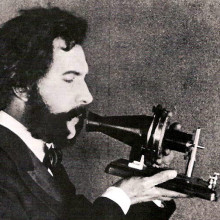
19:14 - This Week in Science History - The First Phone Call
This Week in Science History - The First Phone Call
Sarah Castor-Perry
This week in science history, on 10th March 1876, there was the first documented 2-way transmission of clear human speech between Alexander Graham Bell and his assistant Mr Watson, with the famous phrase "Mr Watson, come here...I want to see you". This first two way conversation marked the beginning of something that is now an overlooked part of everyday life, and although this was one of the most famous occasions in the story of the invention of the telephone, there were many other players involved, not just Bell.
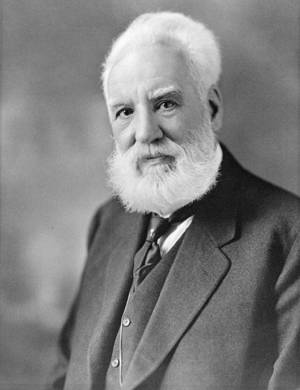 Bell was born and educated in Scotland, and even as a child had been fascinated by the production of sound and language and how it could be reproduced mechanically. This early interest may have been sparked by the fact that his mother was deaf, and his father worked as a speech therapist.
Bell was born and educated in Scotland, and even as a child had been fascinated by the production of sound and language and how it could be reproduced mechanically. This early interest may have been sparked by the fact that his mother was deaf, and his father worked as a speech therapist.
As an adult, his first real experiments that led him into his work on the telephone focused on the artificial production of speech - using a set of differently tuned reeds, a bit like the strings of a harp, to produce different tones according to an alternating current that passed through them. This moved on to producing vowel sounds, which was something other scientists at the time had also achieved, much to Bell's disappointment. But he thought, well if we can make vowel sounds, then why shouldn't consonants and articulate speech be made too?
It was in the early 1870s that the idea of capturing a real voice and using that to generate the current that drove the artificial speech production at the other end really leapt forward. Several scientists, across Europe and in Canada and America, where Bell was living and working, came up with solutions to the problem of how to convert human speech into electrical current, and how to convert that back into speech again.
Two of these solutions - the liquid microphone, an idea that Bell may or may not have pinched from the American Elias Grey, and the electromagnetic microphone, developed both by Bell and by the Italian Antonio Meucci, another contender to the title of the inventor of the telephone.
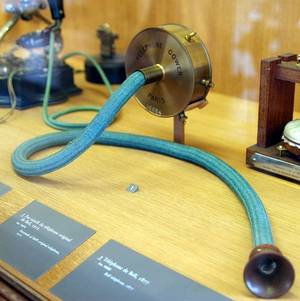 The water microphone, that Bell used in this famous demonstration on the 10th of March, works as follows - the transmitting subject spoke into one end of a tube, and the opposite end was covered in a thin diaphragm of paper or animal skin with a small needle attached to it. When the speech vibrated the diaphragm, the point of the needle would become more or less immersed in a liquid. Another wire measured the change in conductivity in the liquid as the metal needle became more or less submerged. This changed the current in the wire, which cause a rudimentary 'earpiece' to vibrate and produce a copy of the original speech. What's quite controversial is that this apparatus is quite different from that of Bell's previous experiments and was quickly abandoned by him, in favour of the more efficient electromagnet microphone.
The water microphone, that Bell used in this famous demonstration on the 10th of March, works as follows - the transmitting subject spoke into one end of a tube, and the opposite end was covered in a thin diaphragm of paper or animal skin with a small needle attached to it. When the speech vibrated the diaphragm, the point of the needle would become more or less immersed in a liquid. Another wire measured the change in conductivity in the liquid as the metal needle became more or less submerged. This changed the current in the wire, which cause a rudimentary 'earpiece' to vibrate and produce a copy of the original speech. What's quite controversial is that this apparatus is quite different from that of Bell's previous experiments and was quickly abandoned by him, in favour of the more efficient electromagnet microphone.
This works by the principle that moving a piece of soft iron in and out of a coil of wire that is held in a magnetic field will induce a voltage in the coil. The resulting change in current flow causes the exact opposite to happen at the earpiece - the voltage change in a coil at that end causes a flat disc-like piece of soft iron to vibrate in and out of the end of the coil according to the frequency of the sound that went in at the other end. This vibration reproduces the speech. It is by this principle that most high quality microphones , like the one I'm using right now, still work today, although those in telephones use a different sort - the carbon granule microphone invented by Edison.
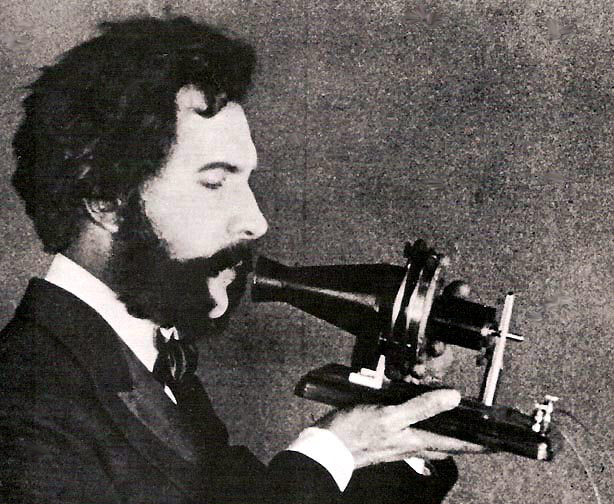 The events of the 10th of March were soon followed by Bell and Watson in August of the same year with the first long distance transmission - over 5 miles. From here, everything about the telephone has been under constant improvement - the distance, the sound quality, the volume, and more recently, the wireless then the mobile phone.
The events of the 10th of March were soon followed by Bell and Watson in August of the same year with the first long distance transmission - over 5 miles. From here, everything about the telephone has been under constant improvement - the distance, the sound quality, the volume, and more recently, the wireless then the mobile phone.
The telephone has revolutionised our world - we can speak to loved ones, friends or business partners thousands of miles away, or get help in an emergency. Bell's work was extremely important in realising the potential of the telephone, but we mustn't forget the other scientists who worked so hard and were just pipped to the patent post by a very talented, or just very lucky man.










Comments
Add a comment